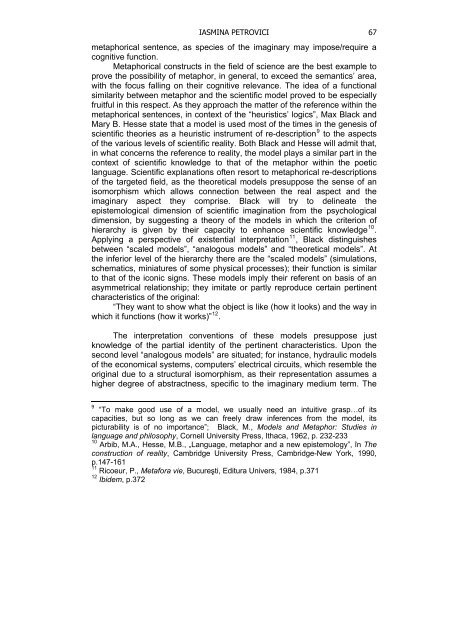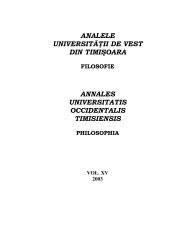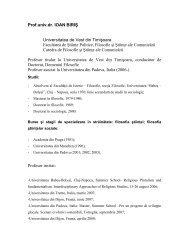VOL. IV (XXI) 2009 - Departamentul de Filosofie si Stiinte ale ...
VOL. IV (XXI) 2009 - Departamentul de Filosofie si Stiinte ale ...
VOL. IV (XXI) 2009 - Departamentul de Filosofie si Stiinte ale ...
You also want an ePaper? Increase the reach of your titles
YUMPU automatically turns print PDFs into web optimized ePapers that Google loves.
IASMINA PETROVICI 67<br />
metaphorical sentence, as species of the imaginary may impose/require a<br />
cognitive function.<br />
Metaphorical constructs in the field of science are the best example to<br />
prove the pos<strong>si</strong>bility of metaphor, in general, to exceed the semantics’ area,<br />
with the focus falling on their cognitive relevance. The i<strong>de</strong>a of a functional<br />
<strong>si</strong>milarity between metaphor and the scientific mo<strong>de</strong>l proved to be especially<br />
fruitful in this respect. As they approach the matter of the reference within the<br />
metaphorical sentences, in context of the “heuristics’ logics”, Max Black and<br />
Mary B. Hesse state that a mo<strong>de</strong>l is used most of the times in the gene<strong>si</strong>s of<br />
scientific theories as a heuristic instrument of re-<strong>de</strong>scription 9 to the aspects<br />
of the various levels of scientific reality. Both Black and Hesse will admit that,<br />
in what concerns the reference to reality, the mo<strong>de</strong>l plays a <strong>si</strong>milar part in the<br />
context of scientific knowledge to that of the metaphor within the poetic<br />
language. Scientific explanations often resort to metaphorical re-<strong>de</strong>scriptions<br />
of the targeted field, as the theoretical mo<strong>de</strong>ls presuppose the sense of an<br />
isomorphism which allows connection between the real aspect and the<br />
imaginary aspect they comprise. Black will try to <strong>de</strong>lineate the<br />
epistemological dimen<strong>si</strong>on of scientific imagination from the psychological<br />
dimen<strong>si</strong>on, by suggesting a theory of the mo<strong>de</strong>ls in which the criterion of<br />
hierarchy is given by their capacity to enhance scientific knowledge 10 .<br />
Applying a perspective of existential interpretation 11 , Black distinguishes<br />
between “sc<strong>ale</strong>d mo<strong>de</strong>ls”, “analogous mo<strong>de</strong>ls” and “theoretical mo<strong>de</strong>ls”. At<br />
the inferior level of the hierarchy there are the “sc<strong>ale</strong>d mo<strong>de</strong>ls” (<strong>si</strong>mulations,<br />
schematics, miniatures of some phy<strong>si</strong>cal processes); their function is <strong>si</strong>milar<br />
to that of the iconic <strong>si</strong>gns. These mo<strong>de</strong>ls imply their referent on ba<strong>si</strong>s of an<br />
asymmetrical relationship; they imitate or partly reproduce certain pertinent<br />
characteristics of the original:<br />
“They want to show what the object is like (how it looks) and the way in<br />
which it functions (how it works)” 12 .<br />
The interpretation conventions of these mo<strong>de</strong>ls presuppose just<br />
knowledge of the partial i<strong>de</strong>ntity of the pertinent characteristics. Upon the<br />
second level “analogous mo<strong>de</strong>ls” are <strong>si</strong>tuated; for instance, hydraulic mo<strong>de</strong>ls<br />
of the economical systems, computers’ electrical circuits, which resemble the<br />
original due to a structural isomorphism, as their representation assumes a<br />
higher <strong>de</strong>gree of abstractness, specific to the imaginary medium term. The<br />
9<br />
“To make good use of a mo<strong>de</strong>l, we usually need an intuitive grasp…of its<br />
capacities, but so long as we can freely draw inferences from the mo<strong>de</strong>l, its<br />
picturability is of no importance”; Black, M., Mo<strong>de</strong>ls and Metaphor: Studies in<br />
language and philosophy, Cornell Univer<strong>si</strong>ty Press, Ithaca, 1962, p. 232-233<br />
10<br />
Arbib, M.A., Hesse, M.B., „Language, metaphor and a new epistemology”, în The<br />
construction of reality, Cambridge Univer<strong>si</strong>ty Press, Cambridge-New York, 1990,<br />
p.147-161<br />
11<br />
Ricoeur, P., Metafora vie, Bucureşti, Editura Univers, 1984, p.371<br />
12<br />
Ibi<strong>de</strong>m, p.372




